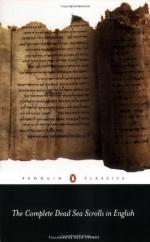|
This section contains 6,261 words (approx. 21 pages at 300 words per page) |

|
In early 1947 Bedouin shepherds investigating a cave in the cliffs northwest of the Dead Sea discovered the first of the scrolls that would be considered the greatest archaeological find of the twentieth century. Within a decade, ten nearby caves were found to contain more scrolls. Scholars soon recognized that these scrolls were 2,000-year-old manuscripts written or collected by an ancient sect, probably the Essenes, living at a site known today as Qumran. These Qumran scrolls form a subset of the Dead Sea Scrolls, which include ancient texts discovered at other locations, such as Masada, Murabbaat, and Nahal Hever. Included among the Qumran manuscripts were sectarian texts describing a community that broke away from the Jewish temple in Jerusalem and lived a pietistic, communal life as they awaited the final battle when God would destroy the wicked and...
|
This section contains 6,261 words (approx. 21 pages at 300 words per page) |

|


